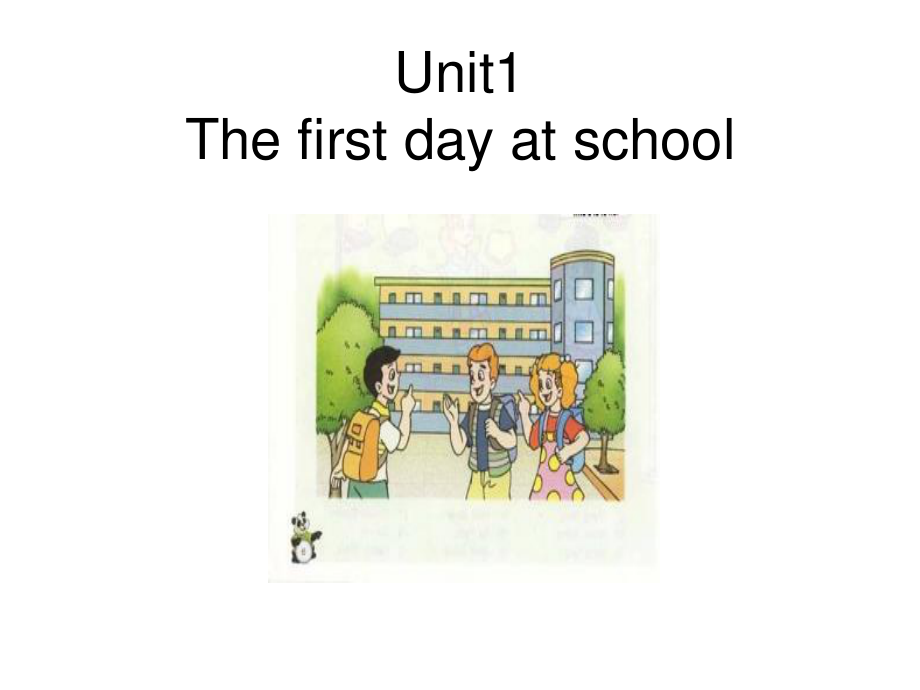《牛津蘇教五上Unit 1 The first day at schoolppt課件》由會(huì)員分享����,可在線閱讀�����,更多相關(guān)《牛津蘇教五上Unit 1 The first day at schoolppt課件(28頁(yè)珍藏版)》請(qǐng)?jiān)谘b配圖網(wǎng)上搜索����。
1���、Unit1 The first day at school Words and Expressions first /f:st/ adj. num 第一(的) day /de/ n.(一)天�����;白天 of / v, v/ prep.所屬�、其中的 term /t:m/ n.學(xué)期 all / :l / adj.&pron. 所有的��;全部 back /bk/ adj.adv.&n. 回(原處) at school 在學(xué)校���;在上課 each other 互相 building /bld/ n. 大樓��;建筑物 a lot (of) 許多����,大量 序數(shù)詞:表示順序的數(shù)詞 first 1st第一(的) seco
2、nd 2nd第二(的) Third 3rd第三(的)fourth 4th第四(的) fifth 5th第五(的) sixth 6th第六(的) seventh 7th第七(的) eighth 8th第八(的) ninth 9th第九(的) tenth 10th第十(的) 序數(shù)詞前面加定冠詞the起到限定�、指定的作用 the first day the second time the fourth month the third student the first English teacher 當(dāng)序數(shù)詞前面已經(jīng)具有了起限定功能的詞修飾的時(shí)候,就不要再加 the 進(jìn)行重復(fù)的限定了����。 my fir
3、st birthday his second chance our third teacher term:學(xué)期 the new term新學(xué)期 this term這個(gè)學(xué)期 the last term上一學(xué)期 the next term下一學(xué)期 the first term第一學(xué)期 the second term第二學(xué)期 of所屬�����,其中的(注意翻譯的順序) the first day of the new term 新學(xué)期的第一天 It is the first day of the new term.今天是新學(xué)期的第一天����。 September 1st is the first day of t
4、he new term.9月1號(hào)是新學(xué)期的第一天���。 新學(xué)期的第七天( ) a book of mine 我的一本書 a leg of the table 桌子的一條腿 man of that time那個(gè)時(shí)代的一個(gè)人 all 所有的�,全部 all the students 所有的學(xué)生 all the class 全班 所有的老師( ) 所有的教室( ) 所有的書( ) 他的所有朋友a(bǔ)ll his friends 所有的錢all money 我的所有錢all my money 所有的時(shí)間all time 我們所有的人 all of us 所有的人 all the world back回(原處)
5��、be back at school 回到學(xué)校上課 All the students are back at school. come back home 回家 go back home回家 Each other 互相 help each other互相幫助 see each other 互相見面 learn from each other 互相學(xué)習(xí) respect each other互相尊重 like each other 互相喜歡 talk to each other 溝通 sb be happy to do sth.某人做某事很開心 They are happy to see each
6���、other again. He is happy to help the child. I am glad to see you again.(又一次) try again 再試一次 jump again再跳一次 count again再數(shù)一次 a lot (of) a lot of =lots of許多的,大量的 后面可以加可數(shù)名詞的復(fù)數(shù)或者不可數(shù)名詞 a lot of rooms/books/computers a lot of time/money/water a lot thanks a lot= thanks very much There is a new building. Th
7����、ere are a lot of rooms in it. There be .句型 表示的是 “某處有(存在)某人或某物”��,其結(jié)構(gòu)為There be (is����,are)+名詞+地點(diǎn)狀語(yǔ)����。 There are 10 students in our class. There is a toilet in our school. 桌子上有一個(gè)電腦。( ) be動(dòng)詞后面有兩個(gè)或兩個(gè)以上的名詞作主語(yǔ)�,be動(dòng)詞要和最靠近它的那個(gè)主語(yǔ)在數(shù)上保持一致,也就是我們常說的 “就近原則”���。 There is an orange and some bananas in the basket. There are so
8�����、me bananas and an orange in the basket. 桌子上有一個(gè)電腦和一些書�。( ) 否定句 1.可以直接在be動(dòng)詞后面加not There is not a new building. There are not many books in his bag. 2.也可以用no來表示 There is no orange in her bag. There are no oranges in her bag. There isnt any juice in the bottle. There is no juice in the bottle. There is a
9�、 garden/swing/slide in our school. ( ) There are some money in my pocket. ( ) 一般疑問句 將be動(dòng)詞提前,結(jié)尾的句號(hào)變問號(hào) 肯定回答:Yes, there is (are). 否定回答:No, there is (are) not. There is a slide in our school. Is there a slide in our school? Yes, there is. No, there is not. There are some flowers in the garden. Are there
10����、 any flowers in the garden? Yes, there are. No ,there are not. There is a reading room in the building. 一般疑問句: 肯定回答: 否定回答: There are many swings on the playground. 一般疑問句: 肯定回答: 否定回答: 特殊疑問句:特殊疑問詞+be動(dòng)詞+其他 對(duì)主語(yǔ)提問 There are some slides in our school. What is in our school? There is a little girl in the r
11、oom. Who is in the room? 注:對(duì)主語(yǔ)進(jìn)行提問時(shí)無(wú)論原句的主語(yǔ)是單數(shù)還是復(fù)數(shù)����,對(duì)其提問時(shí)一般都用be的單數(shù)形式(回答時(shí)卻要根據(jù)實(shí)際情況來決定),并且there會(huì)省略。 對(duì)地點(diǎn)提問 There are four children in the classroom. Where are the four children? There is a table tennis room in the building. Where is the table tennis room? 對(duì)數(shù)量提問 There are 24 classrooms in the building. How
12����、 many classrooms are there in the building? There is a computer in the classroom. How many computers are there in the classroom? 主語(yǔ)是可數(shù)名詞,無(wú)論是單數(shù)還是復(fù)數(shù)��, 在特殊疑問句中be動(dòng)詞都用are There is some money in my purse. How much money is there in your purse? 練習(xí) 1.There are 10 desks and a blackboard in our class. 2.There
13��、is a slide on the playground. 3.There are 5 girls and 8 boys in our class. 4.There are 5 girls and 8 boys in our class. there be句型強(qiáng)調(diào)的是某物或某人的客觀存在��,表示“存在”的“有” There are three trees in front of the house. (強(qiáng)調(diào)存在) have(has)強(qiáng)調(diào)擁有或占有�����,即某物或某人與主語(yǔ)是所屬關(guān)系 I have a book.(強(qiáng)調(diào)所屬) Mr black has two sons. (強(qiáng)調(diào)所屬) toilet /t
14����、lt/ n.廁所 garden /g:dn/ n.花園 swing /sw/ n. 秋千 slide /slad/ n.滑梯;滑道 how many 多少個(gè) there are 有(表示存在�����,復(fù)數(shù)) any /eni/ adj.任何的��,一些 reading room閱覽室(復(fù)數(shù)) reading rooms sure / adj.有把握的 lets =let us 讓我們 how many多少個(gè)����,對(duì)可數(shù)名詞提問 how much 對(duì)不可數(shù)名詞提問 He gives me 3 books. How many books does he give you? There is a computer
15、in my room. How many computers are there in your room? There is a bottle of water on the table. How much water is there on the table? There is some money in my purse. (some用在肯定句中�����,any用在疑問句和否定句中) How much money is there in your purse? lets=let us 祈使句����,表建議“咱們做事吧” Lets go to school. Lets go and see.讓我們?nèi)タ?/p>
16、看�����。 let sb do sth. Let me see.讓我想一想�����。 Let me have a look.讓我看一看���。 Let him have a rest. have a try試一試 have breakfast吃早飯 have a break休息一下 have a meeting開會(huì) there is 有(表示存在���,單數(shù)) table tennis n.乒乓球 Let me see.讓我想一想��。 computer /kmpju:t/ n.電腦 have a look看一看 table tennis room乒乓球室 table tennis rooms computer room
17����、電腦室(微機(jī)室) computer rooms Shall we go and play there? 我們?nèi)ツ抢锿嬖趺礃樱?Shall是情態(tài)動(dòng)詞���,用在問句中表示征求對(duì)方意見,主要用于第一���、第三人稱. 表示.好嗎?要不要.? Shall we go to school now? Shall I wait outside? Shall we begin now? 回答可以是“Good idea”,”Yes, please”, “OK” Sorry�����, I have something else to do. 隨堂練習(xí) 1.在那個(gè)建筑中有許多書��。 2.在我們學(xué)校有24個(gè)教室����。 3.讓我們?nèi)タ纯础?4.我們學(xué)校有1個(gè)閱覽室和2個(gè)乒乓球室。 5.在那個(gè)建筑中有多少書����? 6.誰(shuí)在教室里����? 7.瓶子里沒有一些水��。 Homework 1.單詞3+1+1, 課文跟讀三遍����,復(fù)述一遍�,默寫一遍 2.課后的同步測(cè)試筆試部分以及發(fā)的試卷做完 3.家長(zhǎng)簽字
 牛津蘇教五上Unit 1 The first day at schoolppt課件
牛津蘇教五上Unit 1 The first day at schoolppt課件

